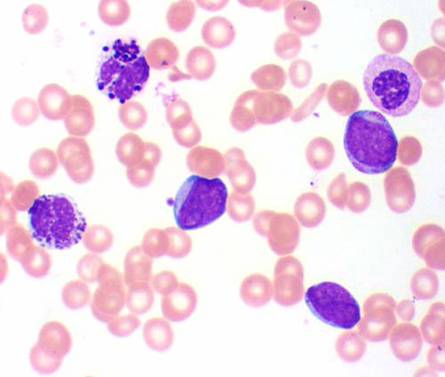Chronic Myelogenous Leukemia
 Chronic
Myelogenous Leukemia is more common in adults than children and is
acquired rather than inherited, although the Philadelphia chromosome
has been implicated in CML cases. Patients with CML tire easily, are
pale, have enlarged spleens, and often have excessive weight loss.
Chronic
Myelogenous Leukemia is more common in adults than children and is
acquired rather than inherited, although the Philadelphia chromosome
has been implicated in CML cases. Patients with CML tire easily, are
pale, have enlarged spleens, and often have excessive weight loss.
Incidence: CML affects about
4,000- 4,600 people each year in the U.S. (Robien and Ulrich, 2003).
Prevalence in children: In
children under 20, CML represents only about 2.6% of leukemia cases.
From ages 1-10, one in one million children gets CML. By age 50, the
rate is nearly two in 100,000 people, and at age 80, 1 in 10,000
people develop CML (Leukemia and Lymphoma Society, 2005).
Average age at onset: The
average age of CML patients is between 45 and 55 years old (Robien
and Ulrich, 2003).
Specific risk factors:
Unlike the other three major types of leukemia, CML is caused by a
translocation on the “Philadelphia chromosome” in stem cells and
the blood cells they produce. The cause of the breakage that allows
the translocation is not known. In some patients, it is caused by
exposure to radiation. The altered chromosome is shorter than normal,
and produces abnormally lengthened proteins that do not function
correctly. The damaged stem cell is able to grow and survive better
than other bone marrow cells and caues an uncontrolled and excessive
amount of white blood cells. The white blood cells are usually able
to function normally (Leukemia and Lymphoma Society, 2005).
Home
References
Cited
Created by Shannon McGlauflin, Jolene Munger, and
Rebecca Nelson, 2005.
 Chronic
Myelogenous Leukemia is more common in adults than children and is
acquired rather than inherited, although the Philadelphia chromosome
has been implicated in CML cases. Patients with CML tire easily, are
pale, have enlarged spleens, and often have excessive weight loss.
Chronic
Myelogenous Leukemia is more common in adults than children and is
acquired rather than inherited, although the Philadelphia chromosome
has been implicated in CML cases. Patients with CML tire easily, are
pale, have enlarged spleens, and often have excessive weight loss.